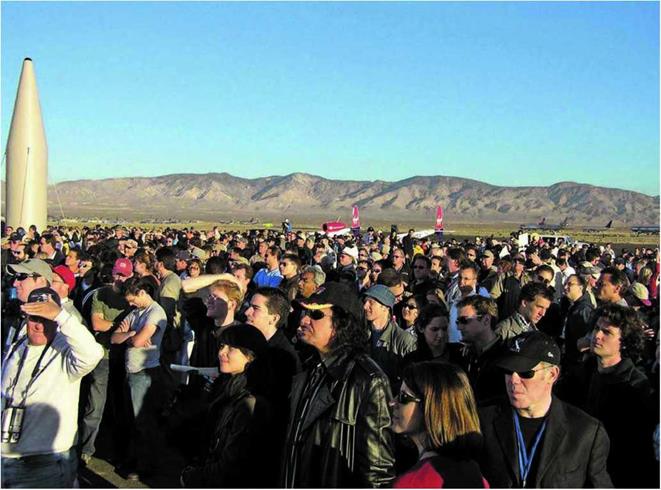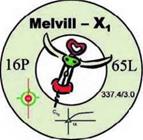Capturing the Anasari X Prize
|
T |
ime was running out. Scaled Composites announced that they would be making their attempt at the Ansari X Prize on September 29, 2004. To win, SpaceShipOne would have to fly not just on that day, but would have to fly once more by October 13th, leaving less than three months before the Ansari X Prize would expire. A major setback would take SpaceShipOne out of contention.
Brian Feeney’s team scheduled to launch their spacecraft Wild Fire on October 2, 2004. But there was a concern as to whether or not they would be ready to launch. What would happen if the January 1,2005, expiration rolled by without a winner?
“We had a contingency plan that whoever won it would get a trophy but not ten million bucks,” Erik Lindbergh said. “But whether or not it would have been as effective was a question. Whether or not it would have gained as much media attention was a question. And also whether or not we would have been able to keep the doors open was a question.”
The X Prize Foundation wanted desperately to award the Ansari X Prize. To them, this wasn’t a one-shot deal. Winning the Ansari X Prize meant jumping the first, but highest by far, hurdle on the path to public space access. But having the prize unclaimed was not their only fear. They knew that progress would only come from the successes and the failures of flying over and over again.
“It was very tense the night before and in the morning as we were gathering in the cold in Mojave to watch the launch,”Anousheh Ansari said. “We were very anxious. We had to prepare ourselves for all sorts of possibilities.”

Ґ
Fig. 9.1. When Mike Melvill made it to space in SpaceShipOne, it was like a great awakening. Scaled Composites gave proof to the world that commercial spaceflight was for real. Millions of people seemed to catch the space craziness as the Ansari X Prize attempts were made and broadcasted
live on television and over the Web. Dan Linehan
V________________________________________________________________________________ J
There was no doubt of the risks involved with spaceflight. And although SpaceShipOne s first spaceflight earlier that June had some unexpected difficulties, the spacecraft and the pilot made it back safely. This was no guarantee for subsequent missions, which would continually stretch the flight envelope. After all, SpaceShipOne was still a research vehicle.
Everyone felt the enormity of the events. “To watch how the wives said goodbye to their husbands before they went up and wished them well was certainly a moment when you felt the responsibility of being involved in a project like this,” Paul Allen said, “and them being worried for their husbands and you being worried, too.” The attempts at the Ansari X Prize would have unprecedented media coverage as well. Tens of thousands of people gathered to
watch the launches in person (refer to figure 9.1 and figure 9.2). And the launches were broadcast live over television and the World Wide Web in a way like none other.
“The whole world was watching,” said Gregg Maryniak, the executive director of the X Prize Foundation. “Most people don’t appreciate that this was the first spaceflight ever that had video coming down that people—regular people—were watching in real time from a manned spaceship. It has never happened before. It has happened where in flight you could see snippets but never during ascent. When was the last time you saw NASA showing footage from inside the shuttle?”
The Ansari X Prize received upwards of six billion media impressions over its course, with a large percentage of them focused
г >1
 Fig. 9.2. A giant screen gave crowds a live, up-close view of SpaceShipOne from inside and outside the cockpit as it made its way to and from space.
Fig. 9.2. A giant screen gave crowds a live, up-close view of SpaceShipOne from inside and outside the cockpit as it made its way to and from space.
These same images were being seen on televisions and computers all over the world.
Dan Linehan
V__________ J

on the small company from the Mojave Desert that was ready to prove that its first spaceflight wasn’t a novelty.
“The entire Tier One team that was taking this vehicle through flight testing had been working really, really hard for the last six weeks or so to where there was almost always someone at Scaled doing something with the vehicle or preparing for the flights or in the simulator,” Brain Binnie said.
“We had a lot of anxiety between our first flight to space with Mike with the lightweight vehicle and trying to decide how we were going to make the adjustment to carrying 600 pounds [270 kilograms] of pay – load for the X Prize flights and still get to those same altitudes. There was concern that the
Flight Test Log Excerpt for 16P
Date: 29 September 2004
Flight Number Pilot/Flight Engineer
SpaceShipOne 16P Mike Melvill
White Knight 65L Brian Binnie/Matt Stinemetze
Objective: First X Prize flight: ballasted to simulate 3 place and to exceed 100 kilometers (328,000 ft).
(source: Mojave Aerospace Ventures LLC, provided courtesy of Scaled Composites)
V__________________________________________ у
rocket motor didn’t have enough energy or impulse for us to get there. We had spent a lot of time worrying about that, wondering whether we needed to augment the motor with some other boosters. We eventually settled on a scheme that was really quite clever, but it took a while to work out the details.”










